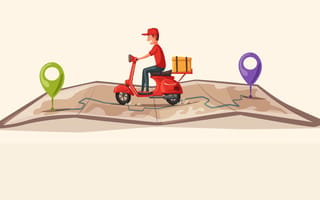A lot of things can happen in the last mile.
Professional marathon runners reserve their energy for the last mile so they can kick it up for the finish line.
The last mile of a road trip is likely to have more serious accidents than the ones before it.
“Going the extra mile” in hiking is an homage to going one mile further into the backcountry than a hiker intended to, often allowing them to see the best views.
For e-commerce business owners, the last mile of shipping is often a logistics nightmare. The final mile of a delivery is usually slow with many stops and changing routes along the way. For a company who needs to find its own means of shipping, this presents a cog in the customer service pipeline, and exactly why Bringg developed a software that helps manage this challenge.
Bringg’s platform allows e-commerce companies to manage each step of the delivery process — tracking, routes, scheduling, dispatching, inventory and so on. — from one view. Bringg services over 800 global customers with the backing of over 200 integrated carriers like parcel and same-day delivery.
In a recent product update, Bringg is allowing customers to take on a piecemeal approach to the platform’s services, allowing more companies to have access to exactly what they need out of the product. Notably, the platform is also now available on Google Cloud Marketplace, allowing customers who use the cloud to quickly have access to the Bringg platform.
Built In sat down with Ryan Leigh, CTO at Bringg to learn more about how the product is evolving to make the last leg easier for its customers.
Macroeconomic conditions this year drove a lot of businesses we work with to evaluate their spending and look to reduce risk in buying cycles. Big transformation projects quickly went out in favor of quicker, more tactical work.
To help our clients and prospects mitigate the risk of their investment, we chose to break our product down into a modular offering, aligned with the kind of maturity journey we see our clients go on.
In other words, they could start with something small — removing the time and change management risk associated with core parts of the platform — then “graduate” into areas with more work involved.
The second reason for doing this was to broaden our total addressable market. It helped us address smaller opportunities beyond the enterprises we traditionally work with, which is an important move for us. We want to address the needs of the entire supply chain, from the top to the bottom. That's our mission: to democratize the last mile.
“We want to address the needs of the entire supply chain, from the top to the bottom. That's our mission — to democratize the last mile.”
What role did your team play in developing and launching the product?
The core platform already existed, which we would usually deliver as part of one big digital transformation like a last-mile enterprise resource planning project. The key was to evaluate how we could reduce the size of these projects to help remove some of the risk for our clients.
We had already started an internal process to understand how our clients evolve over time and how they realize value from the platform at different stages of their journey with us, so it was clear that their needs aligned with a maturity curve. Once we had done the research on our maturity model, we had a reasonable idea of how to proceed.
What teams did you collaborate with in order to get this across the finish line?
This is a task involving Bringgsters across the board. We had to validate our plan with customer service, sales and professional services to ensure that our ideas were sound and our clients would benefit.
We used data from BizOps to work out the business plan and commit to investment. We needed the product team to design and implement tools for handling product-led growth, or PLG, and product marketing to produce new material that would drive PLG within the platform.
We’ve spent months educating our teams, clients and prospects on how this new approach can ensure long term success, reduce churn or failed implementations, and improve ROI throughout the journey.
The main tool we employed was clear communication across the business on why we were making the changes and how they would help us move forwards. I also believe in working collaboratively across departments and allowing people to focus on their area of speciality, this ensured everyone was invested in the changes we were making.
When you think of other companies in your industry, what’s different about Bringg?
We always have one eye on the long-term goals of the company. We share that vision regularly with our teams and with our clients. We focus on the “why.” Everything we do between now and then is to help achieve those long term goals, which includes the work we did to make the platform modular and removing risk from the projects we deliver.
“The main tool we employed was clear communication across the business on why we were making the changes and how they would help us move forwards.”
I mentioned before how we believe our mission is to level the playing field for all players in the last mile space; achieving this modular approach was a huge milestone in reaching that goal.






